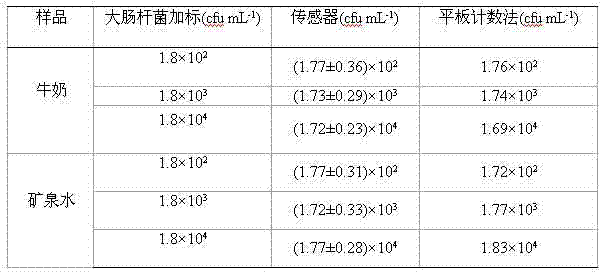Biosensor for detecting escherichia coli and preparation method thereof
A biosensor, Escherichia coli technology, applied in the field of sensors, can solve problems such as complex operation of the instrument, and achieve the effects of good repeatability, fast online detection, and stable electrode performance
- Summary
- Abstract
- Description
- Claims
- Application Information
AI Technical Summary
Problems solved by technology
Method used
Image
Examples
Embodiment 2
[0054] A comparative experiment of a method for preparing an electrochemical sensor for detecting Escherichia coli, the steps are as follows:
[0055] a. Two gold electrodes are first polished in 0.3 and 0.05 μm alumina slurry until they become mirror surfaces, and then rinsed with secondary water;
[0056] b. Prepare 2% glutaraldehyde solution, use this solution to cross-link the E. coli antibody to the surface of the electrode, dry it for 60 minutes, and rinse the electrode with secondary water and PBS to remove unbound antibody;
[0057] c. After washing several times with secondary water, modify the bovine serum albumin behind the glutaraldehyde-E. coli antibody layer, so that the bovine serum albumin can block the non-specific binding site;
[0058] The detection method is as follows:
[0059] d. After fully agitating and washing in PBS buffer, incubate in E. coli bacteria solution, wash with PBS buffer, E. coli will bind to the electrode due to the specific binding betw...
Embodiment 3
[0067] A kind of stability analysis of the electrochemical sensor that detects escherichia coli, the steps are as follows:
[0068] a. The 4 gold electrodes are first polished in 0.3 and 0.05 μm alumina slurry until they become a mirror surface, and rinsed with secondary water;
[0069] b. Prepare 2% glutaraldehyde solution, use this solution to cross-link the E. coli antibody to the surface of the electrode, dry it for 60 minutes, and rinse the electrode with secondary water and PBS to remove unbound antibody;
[0070] c. After washing several times with secondary water, modify the bovine serum albumin behind the glutaraldehyde-E. coli antibody layer, so that the bovine serum albumin can block the non-specific binding site;
[0071] The detection method is as follows:
[0072] d. After the electrode is fully agitated and cleaned in PBS buffer, it is incubated in E. coli bacteria solution and washed with PBS buffer. E. coli is bound to the electrode due to the specific bindin...
Embodiment 4
[0079] A kind of standard curve drawing and practical application of the preparation method of the electrochemical sensor that detects Escherichia coli, the steps are as follows:
[0080] a. The 6 gold electrodes are first polished in 0.3 and 0.05 μm alumina slurry until they become a mirror surface, and rinsed with secondary water;
[0081] b. Prepare 2% glutaraldehyde solution, use this solution to cross-link the E. coli antibody to the surface of the electrode, dry it for 60 minutes, and rinse the electrode with secondary water and PBS to remove unbound antibody;
[0082] c. After washing several times with secondary water, modify the bovine serum albumin behind the glutaraldehyde-E. coli antibody layer, so that the bovine serum albumin can block the non-specific binding site;
[0083] The detection method is as follows:
[0084] d. After the electrode is fully agitated and washed in PBS buffer, it is 0, 1.8×10, 1.8×10 in E. coli bacteria solution 2 , 1.8×10 3 , 1.8×10 ...
PUM
| Property | Measurement | Unit |
|---|---|---|
| thickness | aaaaa | aaaaa |
| thickness | aaaaa | aaaaa |
| thickness | aaaaa | aaaaa |
Abstract
Description
Claims
Application Information
 Login to View More
Login to View More - R&D
- Intellectual Property
- Life Sciences
- Materials
- Tech Scout
- Unparalleled Data Quality
- Higher Quality Content
- 60% Fewer Hallucinations
Browse by: Latest US Patents, China's latest patents, Technical Efficacy Thesaurus, Application Domain, Technology Topic, Popular Technical Reports.
© 2025 PatSnap. All rights reserved.Legal|Privacy policy|Modern Slavery Act Transparency Statement|Sitemap|About US| Contact US: help@patsnap.com



